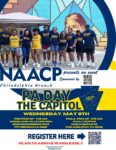ABOVE PHOTO: Elfreth’s Alley.
By Renée S. Gordon
“Numerous as his achievements were, they were less than he was”
–Carl Van Doren
There is no one in the United States whose life has not been touched by the legacy of Benjamin Franklin. If you have ever received mail, visited a library, or jumped into a pool wearing swim fins on your feet (he invented them) then you have benefitted from his genius. A chronicle of his achievements and character traits is both long and expansive and includes those qualities we often link with him, intelligence, wit, tenacity, frugality and diplomacy. He did indeed exhibit these behaviors but the quality I personally find to be his most outstanding was his ability to grow intellectually, change his opinion and alter his course based upon what he learned.
Although Franklin was not born in Philadelphia he is most closely connected with it and it is the city he called home. The recent reopening of the Benjamin Franklin Museum has provided a great opportunity for visitors to explore his life and times through tours of places he would have visited, sculptural depictions and institutions that are part of his legacy. Many of the sites are free and entrance fees are minimal at others. This makes a wonderful day to share with your family and a complete itinerary with information and maps can be found on www.visitphilly.com/ben
Philadelphia on Foot Tours, led by Edward Mauger, offers the best historic overview of Franklin’s time in Philadelphia. This much lauded tour has been designated “Philadelphia’s Best Tour” by Forbes Traveler. Reservations are available in advance. 215-627-8680. www.ushistory.org/more/mauger
Franklin was born in Boston on January 17, 1706, the 15th of 17 children. Records indicate that, because the family was poor, he received a maximum of two years formal education but he continued a course of self-education through avid reading for the remainder of his life. In 1762, he was awarded an honorary doctorate from England’s Oxford University as well as degrees from Harvard, Yale, William and Mary College, and the University of St. Andrews in Scotland.
At the age of 12, from 1718-23, Franklin was apprenticed to his brother James to learn the printing trade. His dislike of his treatment caused him to flee to Philadelphia, a crime because he was contracted to his brother.
On October 6, 1723, young Ben landed at the foot of High Street, now Market, and walked to the Quaker Meeting House located at second Street. He rested there for a while and then proceeded to purchase three loaves of bread with his remaining 3 cents. Eating one loaf and with one loaf under each arm he encountered 15-year old Deborah Read, later to become his common-law wife, in the middle of Third Street. Deborah’s father, a builder and carpenter, rented Ben a room and until his death 67 years later, though he would become the most travelled man in the country, Colonial Philadelphia would be the city he called home. In 1728 he established a printing office with partner Hugh Meredith and three years later he started one of the nation’s first printing franchises. The following year he published America’s first German language newspaper Philadelphische Zeitung. In 1748 at the age of 42, Franklin retired to pursue his political career and continue his experiments with electricity.
A stroll through Franklin’s Philadelphia should begin at the foot of Market Street, a stretch that he trod often. Originally High Street, it became known as Market Street after Penn himself ordered that the city’s 100-ft. wide main thoroughfare hold a regular market in the middle of the street. The name did not become official until 1858. Lining the street were inns, ordinaries, taverns, coffee houses and businesses. The second London Coffee House opened in 1754 on the corner of 2nd and Market. This was the site of visits by Franklin and his contemporaries. Slave auctions were held here and handbills, printed by Franklin, regarding runaways were posted.
The original City Tavern, also known as Merchant’s Tavern, was constructed in 1773 and was a favorite of colonial society. The famous diners included not only the Founding Fathers but also Martha Washington, Abigail Adams, Paul Revere, Lafayette and, of course, Franklin himself. City Tavern is currently a historic restaurant with colonial garbed servers and early American cuisine. www.citytavern.com
Franklin worshiped in the 1727 Christ Church and on those occasions he sat in pew #70. His children were baptized in the church and on October 29, 1767 his daughter was married there. The steeple was a later addition and Franklin hoped to conduct his electricity experiments there. Because it took so long to construct he used a kite instead.
The current church replaced an earlier 1697 log and brick structure and was the tallest building erected in the 18th-century. It is considered one of the finest examples of Georgian red brick architecture. The interior is beautiful and features transparent windows, Washington’s pew 54, John Penn’s gravesite and the 600-year old baptismal font used at William Penn’s baptism. www.christchurchphila.org
Two friends of Franklin resided in Elfreth’s Alley, the oldest residential street in the country. Thirty-two privately owned houses are found on what began as a cart path populated by artisans and craftsmen of all nationalities. The buildings date from 1702 and their history is related in a museum located inside #126. Elfreth’s Alley National Historic District offers regularly scheduled events. www.elfrethsalley.org
Several signers of the Declaration of Independence are interred in the two acre Christ Church Burial Ground. Franklin’s grave, along with that of Deborah and two children, is located just inside the cemetery and is usually covered with pennies tossed by passersby. His grave can be viewed without entering the burial ground. On the wall outside there is a bronze plaque detailing milestones of Franklin’s life. www.christchurchphila.org/burial
Carpenter’s Hall was constructed in 1770 and hosted the first meeting of the Continental Congress in 1774. In 1733 Franklin established Franklin’s Library Company, the nation’s first circulating library, and for a time the library was located here. Modern visitors can view displays of original furniture on the first floor and the first Congressional Library on the second floor of the building. While the building functioned as the Bank of Pennsylvania it was the scene of the first bank robbery in the country. www.carpentershall.org
B. Free Franklin Post Office interprets Franklin’s role as the first postmaster general and is an active post office. The interior replicates an early postal facility and visitors can have mail hand cancelled with a unique postmark.
Adjoining the post office is Franklin’s Print Shop. Inside you can watch demonstrations of printing techniques and devices common in the 18th-century. www.uspspostoffices.com/pa/philadelphia/b-free-franklin
The 20,000-sq. ft. renovated underground Benjamin Franklin Museum is the city’s newest attraction. The museum is divided into five galleries, each based on one of his character traits, and a library. The museum has 30 creatively interactive computer stations that both engage and enlighten. Highlights of the collection are his personal Bible, chess set, chairs from his home and a 1761 copy of Poor Richard’s Almanack.
After Franklin’s death his grandchildren razed his mansion and built rental houses in its place. Identification of the area that was Franklin Court began in the late 1940s. In 1976 two steel-framed ghost structures outlined the footprint of his property. These structures continue to be located adjacent to the museum. www.nps.gov/inde/planyourvisit/franklin-court
At various times throughout his life Franklin owned slaves and the two whose names we know were King and George. By all accounts Franklin was not anti-slavery in his youth but after visiting a school for African American children began to alter his opinion. He wrote a friend stating that he,” conceived a higher opinion of the natural capacities of the black race, than I had ever before entertained.” In 1785, he joined the Society for Promoting the Abolition of Slavery and the Relief of Negroes Unlawfully Held in Bondage and in 1787, became its president. He later he began writing against the continuation of slavery although in his autobiography, the first written in America, he never mentions the issue. Franklin’s final public act in 1790 was to submit a petition from the Society to Congress requesting an end to both the slave trade and slavery. He died in April of that year.
Benjamin Franklin is depicted throughout the city in various mediums. My two personal favorites are the seated Benjamin Franklin by George Lundeen on Locust Walk on the University of Pennsylvannia campus and Joseph Brown’s Young Benjamin Franklin on the grounds of the Municipal Services Building is also great. It shows a youthful Ben at his printing press. They provide great photo ops.
Franklin’s legacy and his hopes for America are best showcased in the National Constitution Center. It is the sole nonpartisan facility in the country dedicated to the U. S. Constitution and its commitment to freedom. The two-story center opened on July 4, 2003 with photographs, interactive exhibits, scale models, artifacts and an original copy of the first printing of the U. S. Constitution signed on September 17, 1787 by delegates from 12 of the original 13 colonies.
Highlights of a visit include a 17-minute 360-degree film, “Freedom Rising.” It relates the ways in which freedom has been interpreted throughout America’s history. On a visit to Signers’ Hall you can walk among forty-two life-sized bronze statues that replicate the Founding Fathers who were present at the signing of the document. Benjamin Franklin sits regally in their midst seemingly caught in mid-comment. www.constitutioncenter.org
Benjamin Franklin left an indelible stamp on the country in general and Philadelphia particularly. You can follow his well-marked trail and gain a more comprehensive understanding of the colonial era and the man that is considered the most approachable of the Founding Fathers. Set out with information that can be found online at www.visitphilly.com
“Any fool can criticize, condemn and complain and most fools do.” B. Franklin
I wish you smooth travels!
TRAVEL TIPS:
The National Constitution Center (NCC) has an ongoing program of events and special exhibits that are open to the public. On September 10, 2013 Hillary Rodham Clinton was awarded the National Liberty Medal for her lifelong public service and her adherence to the ideals of “active citizenship.” Ideals Franklin considered essential to a healthy democracy.
Benjamin Franklin would be justifiably proud of the current special exhibit on display at the NCC from October 11 to December 31, 2013, “Capture the Moment: The Pulitzer Prize Photographs”. More than 150 photographs dating from 1942 on, relate the stories of “we the people” through triumph and tragedy, in our finest hours and in the moments of our despair. The iconic winners are there, “Raising the Flag on Mt. Suribachi,” “Kent State Massacre,” “Jack Ruby Shoots Lee Harvey Oswald,” but there are also works, no less moving, with which we are less familiar. These images are brought to you thanks to the First Amendment and insightful men like Benjamin Franklin. Do not miss this exhibit. www.constitutioncenter.org/experience/exhibitions
Thursday, November 14, 2013 will be the inauguration of a new holiday tradition, Franklin Square’s Electrical Spectacle: A Holiday Light Show. The square, located at 6th and Market, will feature a 10-ft. kite and key and musical light shows including 50,000 lights. The Lightning Bolt Holiday Express will take you on a train ride around the square for $5.00, there will be guest stars and eight shows will be presented nightly until December 31st. www.historicphiladelphia.org














Leave a Comment